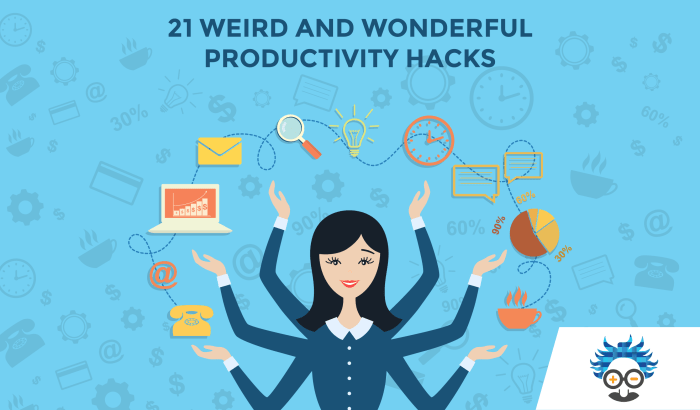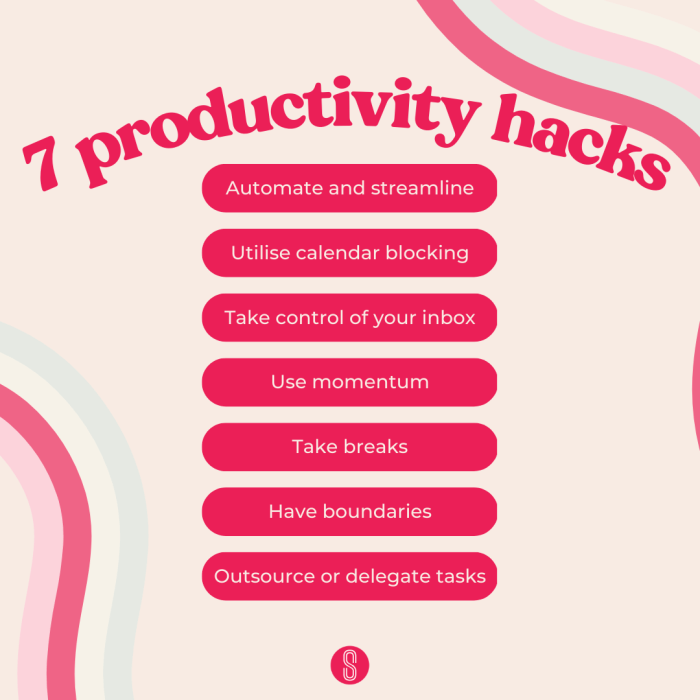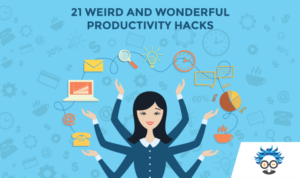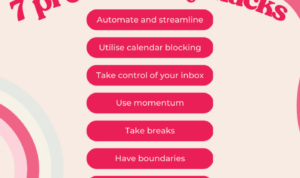Productivity Hacks, a term buzzing in the air, is all about finding clever ways to amp up your productivity game. Whether you’re a student juggling assignments or a professional managing deadlines, these hacks are your secret weapons to staying on top of your game. Let’s dive in and uncover the secrets to maximizing your output with ease.
Definition of Productivity Hacks
Productivity hacks are strategies, techniques, or tools that individuals or teams use to improve their efficiency and effectiveness in completing tasks and achieving goals. These hacks are designed to help streamline workflows, eliminate distractions, and maximize output in a shorter amount of time.
Examples of Common Productivity Hacks
- Time blocking: Allocating specific time slots for different tasks to focus on one thing at a time.
- Pomodoro technique: Breaking work into intervals with short breaks in between to maintain focus and productivity.
- Task prioritization: Identifying and tackling high-priority tasks first to ensure important deadlines are met.
- Setting SMART goals: Establishing specific, measurable, achievable, relevant, and time-bound objectives to stay on track.
Benefits of Implementing Productivity Hacks
- Increased efficiency: Productivity hacks help individuals and teams work smarter, not harder, by optimizing their time and resources.
- Reduced stress: By organizing tasks and managing time effectively, productivity hacks can alleviate feelings of overwhelm and anxiety.
- Improved focus: Eliminating distractions and implementing productivity hacks can enhance concentration and attention to detail.
- Enhanced work-life balance: By boosting productivity and completing tasks more efficiently, individuals can create more time for personal activities and relaxation.
Time Management Techniques: Productivity Hacks

Effective time management is essential for improving productivity. By utilizing various strategies, individuals can make the most of their time and accomplish tasks efficiently. One popular technique that has been proven to enhance focus and productivity is the Pomodoro Technique. This method involves breaking work into intervals, typically 25 minutes of focused work followed by a short break. This helps prevent burnout and allows for better concentration on tasks at hand.
The Pomodoro Technique
The Pomodoro Technique is a time management method developed by Francesco Cirillo in the late 1980s. It involves breaking work into short intervals, known as Pomodoros, usually 25 minutes long. After each Pomodoro, a short break of 5 minutes is taken. After completing four Pomodoros, a longer break of 15-30 minutes is recommended. This technique helps individuals maintain focus, manage distractions, and improve productivity by working in short, concentrated bursts.
Tips for Prioritizing Tasks
- Make a to-do list: Write down all tasks that need to be completed and prioritize them based on deadlines or importance.
- Use the Eisenhower Matrix: Categorize tasks into four quadrants – urgent and important, important but not urgent, urgent but not important, neither urgent nor important. Focus on tasks in the first two quadrants.
- Set realistic deadlines: Assign specific deadlines to tasks to avoid procrastination and ensure timely completion.
- Avoid multitasking: Concentrate on one task at a time to improve efficiency and reduce errors.
Organization Methods
Organizing your workspace, digital files, and schedules is key to boosting productivity. By decluttering and implementing effective organization methods, you can streamline your workflow and focus better on tasks at hand.
Workspace Organization
Having a clean and organized workspace can significantly impact your productivity. Here are some tips to keep your workspace in tip-top shape:
- Keep only the essentials on your desk to minimize distractions.
- Use storage solutions like shelves, drawers, and organizers to declutter your space.
- Create a filing system for papers and documents to easily locate what you need.
Digital File Organization
Managing your digital files efficiently is crucial for staying organized. Here are some strategies to organize your digital files effectively:
- Create folders and subfolders to categorize your files based on projects or subjects.
- Use descriptive file names to quickly identify the content of each file.
- Regularly backup your files to prevent data loss and keep your digital workspace clutter-free.
Schedule Organization
Organizing your schedule helps you prioritize tasks and manage your time effectively. Here are some tips for scheduling and task management:
- Create daily to-do lists to track your tasks and ensure nothing falls through the cracks.
- Use productivity tools like calendars, task managers, and reminder apps to stay on top of deadlines and appointments.
- Block out time for focused work sessions to avoid multitasking and improve productivity.
Mindfulness and Mental Well-being

Maintaining mental well-being is crucial for productivity. When our minds are in a good place, we can focus better, think clearly, and tackle tasks more efficiently. Mindfulness practices can help reduce stress levels, increase concentration, and enhance overall mental wellness.
Benefits of Mindfulness, Productivity Hacks
- Reduces stress and anxiety
- Improves focus and concentration
- Enhances creativity and problem-solving skills
- Promotes emotional regulation and resilience
Techniques for Work-Life Balance
- Set boundaries between work and personal life
- Take regular breaks to recharge and reset
- Practice self-care activities such as exercise, meditation, or hobbies
- Prioritize tasks based on importance and deadlines










